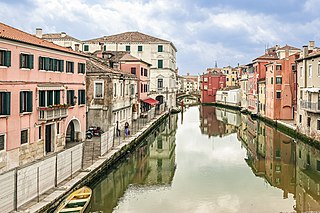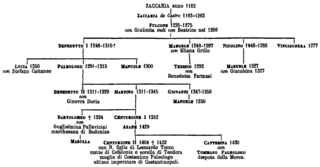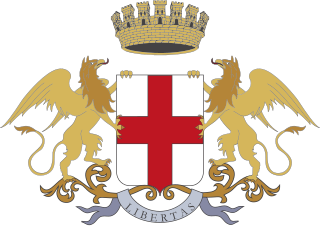Related Research Articles

Year 1258 (MCCLVIII) was a common year starting on Tuesday of the Julian calendar.

The Republic of Genoa was a medieval and early modern maritime republic from the years 1099 to 1797 in Liguria on the northwestern Italian coast. During the Late Middle Ages, it was a major commercial power in both the Mediterranean Sea and the Black Sea. Between the 16th and 17th centuries, it was one of the major financial centers in Europe.
The Battle of Chioggia was a naval battle during the War of Chioggia that culminated on June 24, 1380 in the lagoon off Chioggia, Italy, between the Venetian and the Genoese fleets. The Genoese, commanded by Admiral Pietro Doria, had captured the little fishing port in August the preceding year.

The War of Chioggia was a conflict between the Republic of Genoa and the Republic of Venice which lasted from 1378 to 1381, from which Venice emerged triumphant. It was the last major conflict of the Venetian–Genoese Wars. The war had mixed results. Venice and her allies won the war against their rival Italian states, but lost the war against King Louis the Great of Hungary, which resulted in the Hungarian conquest of the Dalmatian city-states.

The Battle of Meloria was fought near the islet of Meloria in the Ligurian Sea on 5 and 6 August 1284 between the fleets of the Republics of Genoa and Pisa as part of the Genoese-Pisan War. The victory of Genoa and the destruction of the Pisan fleet marked the decline of the Republic of Pisa.
The military history of the Republic of Venice started shortly after its founding, spanning a period from the 9th century until the Republic's fall in the 18th century.

The War of Saint Sabas (1256–1270) was a conflict between the rival Italian maritime republics of Genoa and Venice, over control of Acre, in the Kingdom of Jerusalem.

The maritime republics, also called merchant republics, were Italian thalassocratic port cities which, starting from the Middle Ages, enjoyed political autonomy and economic prosperity brought about by their maritime activities. The term, coined during the 19th century, generally refers to four Italian cities, whose coats of arms have been shown since 1947 on the flags of the Italian Navy and the Italian Merchant Navy: Amalfi, Genoa, Pisa, and Venice. In addition to the four best known cities, Ancona, Gaeta, Noli, and, in Dalmatia, Ragusa, are also considered maritime republics; in certain historical periods, they had no secondary importance compared to some of the better known cities.

Benedetto I Zaccaria was an Italian admiral of the Republic of Genoa. He was the Lord of Phocaea and first Lord of Chios, and the founder of Zaccaria fortunes in Byzantine and Latin Greece. He was, at different stages in his life, a diplomat, adventurer, mercenary, and statesman.
The Venetian–Genoese Wars were a series of struggles between the Republic of Genoa and the Republic of Venice, at times allied with other powers, for dominance in the Mediterranean Sea between 1256 and 1381. There were four bouts of open warfare, in which the fighting between the two republics took place largely at sea. Even during periods of peace, incidents of piracy and other minor outbreaks of violence between the two trading communities were commonplace.

The Battle of Settepozzi was fought in the first half of 1263 off the Greek island of Settepozzi between a Genoese–Byzantine fleet and a smaller Venetian fleet.

Giovanni II Valente was the third doge of the Republic of Genoa. His time in office was marked by the crushing defeat of the city against the Venetians at the naval Battle of Alghero. Giovanni had already asked to succeed the first doge of the Republic in December 1345 but had turn down the responsibility.

The Venetian navy was the navy of the Venetian Republic which played an important role in the history of the republic and the Mediterranean world. It was the premier navy in the Mediterranean Sea for many centuries between the medieval and early modern periods, providing Venice with control and influence over trade and politics far in excess of the republic's size and population. It was one of the first navies to mount gunpowder weapons aboard ships, and through an organised system of naval dockyards, armouries and chandlers was able to continually keep ships at sea and rapidly replace losses. The Venetian Arsenal was one of the greatest concentrations of industrial capacity prior to the Industrial Revolution and responsible for the bulk of the republic's naval power.
The Battle of Modon was fought on 7 October 1403 between the fleets of the Republic of Venice and of the Republic of Genoa, then under French control, commanded by the French marshal Jean Le Maingre, better known as Boucicaut. One of the last clashes in the Venetian–Genoese wars, the battle ended in a decisive Venetian victory.

The Genoese navy was the naval contingent of the Republic of Genoa's military. From the 11th century onward the Genoese navy protected the interests of the republic and projected its power throughout the Mediterranean and Black Seas. It played a crucial role in the history of the republic as a thalassocracy and a maritime trading power.

The War of Curzola was fought between the Republic of Venice and the Republic of Genoa due to increasing hostile relations between the two Italian republics. Spurred largely by a need for action following the commercially devastating Fall of Acre, Genoa and Venice were both looking for ways to increase their dominance in the Eastern Mediterranean and Black Sea. Following the expiration of a truce between the republics, Genoese ships continually harassed Venetian merchants in the Aegean Sea.

The Battle of Trapani took place on 23 June 1266 off Trapani, Sicily, between the fleets of the Republic of Genoa and the Republic of Venice, as part of the War of Saint Sabas (1256–1270). During the war, the Venetians held the upper hand in naval confrontations, forcing the Genoese to resort to commerce raiding and avoiding fleet battles. In the 1266 campaign, the Genoese had an advantage in numbers, but this was not known to the Genoese commander, Lanfranco Borbonino. As a result, the Genoese tarried at Corsica until the end of May. The Venetian fleet under Jacopo Dondulo, was left to sail back and forth awaiting the appearance of the Genoese fleet in the waters around southern Italy and Sicily. Fearing that the other side had more ships, both sides reinforced their fleets with additional ships, but the Genoese retained a small numerical advantage.
The Battle of Saseno took place on 14 August 1264 near Saseno Island off the coast of Albania, between a fleet of the Republic of Genoa and a trade convoy of the Republic of Venice, during the War of Saint Sabas. Since the outbreak of the war in 1256, the Genoese had experienced only defeats in direct confrontations with the Venetian navy, and had therefore resorted to raiding the Venetian commerce convoys to the Levant that were critical to the Venetian economy.
Jacopo Dondulo was a Venetian sailor, military commander, and politician in the 13th century. He played a distinguished role in the naval conflicts of the War of Saint Sabas against the Republic of Venice, leading the Venetian navy to a crushing victory at the Battle of Trapani in 1266. He served also several tenures as a member of the Great Council of Venice, as Bailo of Negroponte in 1277–1279, and as Duke of Candia in 1281–1283, where he faced the start of the Revolt of Alexios Kallergis.
Simone Guercio was a Genoese noble and military commander and official in the service of the Republic of Genoa during the third quarter of the 13th century.
References
- ↑ Stanton 2015, pp. 182–184.
- ↑ Marshall 1994, pp. 39–40, 225.